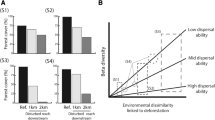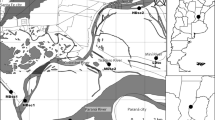Abstract
We investigated (1) the variation of both species composition and species relative abundances of aquatic beetles associated with submerged woody debris in a transitional region between Cerrado (Brazilian savannah) and Atlantic Forest biomes; and (2) which assembling processes are more associated with the observed patterns, species sorting or mass effects. We hypothesized that the marked differences between Cerrado and Atlantic Forest streams regarding vegetation composition and structure would produce different environmental conditions for stream beetle faunas assembling. We used spatial explicit multivariate techniques to analyze whether metacommunity patterns were more associated with environmental variables, indicating a major role of species sorting, or with spatial variables, indicating intense dispersal. We found distinct communities within each biome in terms of both changes in taxonomic composition and species relative abundance driven by environmental factors. Biome type, a regional scale variable, and variation in dissolved oxygen levels, a local scale variable, were the best explanatory variables of variation in metacommunity structure. We did not find any evidence of the influence of processes related to the spatial configuration of streams. Altogether our results pointed to species sorting structuring saproxylic beetles assemblages patterns.




Similar content being viewed by others
References
Anderson MJ (2001) A new method for non-parametric multivariate analysis of variance. Aust Ecol 26:32–46
Anderson MJ, Ellingsen KE, McArdle BH (2006) Multivariate dispersion as a measure of beta diversity. Ecol Lett 9:683–693
Bilton DT, Freeland JR, Okamura B (2001) Dispersal in freshwater invertebrates. Annu Rev Ecol Syst 32:159–181
Blanchet FG, Legendre P, Borcard D (2008) Forward selection of explanatory variables. Ecology 89:2623–2632
Borcard D, Legendre P (2002) All-scale spatial analysis of ecological data by means of principal coordinates of neighbour matrices. Ecol Model 153:51–68
Borcard D, Legendre P, Drapeau P (1992) Partialling out the spatial component of ecological variation. Ecology 73:1045–1055
Brown HP (1987) Biology of riffle beetles. Ann Rev Entomol 32:253–273
Cadol D, Wohl E, Goode JR, Jaeger KL (2009) Wood distribution in neotropical forested headwater streams of La Selva, Costa Rica. Earth Surf Proc Land 34:1198–1215
Chave J, Muller-Landau HC, Baker TR, Easdale TA, Steege HT, Webb CO (2006) Regional and phylogenetic variation of wood density across 2456 neotropical tree species. Ecol Appl 16:2356–2367
Connolly NM, Crossland MR, Pearson RG (2004) Effect of low dissolved oxygen on survival, emergence, and drift of tropical stream macroinvertebrates. J N Am Benthol Soc 23:251–270
Corkum LD (1992) Spatial distributional patterns of macroinvertebrates along rivers within and among biomes. Hydrobiologia 239:101–114
Cranston P, McKie B (2006) Aquatic wood—an insect perspective. In: Grove SJ, Hanula JL (eds) Insect biodiversity and dead wood: proceedings of a symposium for the 22nd international congress of entomology. US Department of Agriculture Forest Service, Asheville, pp 9–14
Domínguez E, Fernández HR (2009) Macroinvertebrados bentónicos sudamericanos: sistemática y biologia. Fundación Miguel Lillo, Tucumán
Dray S, Legendre P, Peres-Neto PR (2006) Spatial modelling: a comprehensive framework for principal coordinate analysis of neighbour matrices (PCNM). Ecol Model 196:483–493
Dray S, Legendre P, Blanchet G (2011) packfor: forward selection with permutation. R package version 0.0-8/r100
Dufrêne M, Legendre P (1997) Species assemblages and indicator species: the need for a flexible asymmetrical approach. Ecol Monogr 67:345–366
Durigan G (2006) Observations on the Southern Cerrados and their relationship with the core area. In: Pennington RT, Lewis GP, Ratter JA (eds) Neotropical savannas and seasonally dry forests: plant diversity, biogeography, and conservation. CRC Press, New York, pp 67–77
Ellicott JM (2008) The ecology of riffle beetles (Coleoptera: Elmidae). Freshw Rev 1:189–203
Feminella JW (2000) Correspondence between stream macroinvertebrate assemblage and 4 ecoregions of the southeastern USA. J N Am Benthol Soc 19:442–461
Fundação SOS Mata Atlântica (2013) Atlas dos remanescentes florestais da mata atlântica período 2011–2012. São Paulo. https://www.sosma.org.br/wp-content/uploads/2013/06/atlas_2011-2012_relatorio_tecnico_2013final.pdf
Gosz JR, Sharpe PJH (1989) Broad-scale concepts for interactions of climate, topography, and biota at biome transitions. Landsc Ecol 3:229–243
Griffith DA, Peres-Neto P (2006) Spatial modeling in ecology: the flexibility of eigenfunction spatial analyses. Ecology 87:2603–2613
Hoffmann A, Hering D (2000) Wood-associated macroinvertebrate fauna in Central European streams. Int Rev Hydrobiol 85:25–48
Kaller MD, Kelso WE (2007) Association of macroinvertebrate assemblages with dissolved oxygen concentration and wood surface area in a selected subtropical streams of the southeastern USA. Aquat Ecol 41:95–110
Kronka FJN, Nalon MA, Matsukuma CK, Kanashiro MM, Ywane MSS, Pavão M, Durigan G, Lima LMPR, Guillaumon JR, Baitello JB, Borgo SC, Manetti LA, Barradas AMF, Fukuda JC, Shida CN, Monteiro CHB, Pontinha AAS, Andrade GG, Barbosa O, Soares AP (2005) Inventário florestal da vegetação natural do estado de São Paulo. Secretaria do Meio Ambiente; Instituto Florestal; Imprensa Oficial, São Paulo, p 200p
Legendre P, Gallagher ED (2001) Ecologically meaningful transformations for ordination of species data. Oecologia 129:271–280
Legendre P, Legendre L (2012) Numerical ecology. Elsevier, Amsterdam
Leibold MA, Holyoak M, Mouquet N, Amarasekare P, Chase JM, Hoopes MFF, Holt RD, Shurin JB, Law R, Tilman D, Loreau M, Gonzalez A (2004) The metacommunity concept: a framework for multi-scale community ecology. Ecol Lett 7:601–613
Liquori MK (2006) Post-harvest riparian buffer response: implications for wood recruitment modelling and buffer design. J Am Water Resour As 4184:177–189
Logue JB, Mouquet N, Peter H, Hillebrand H, Declerck P, Flohre A, Gantner S, Gulzow N, Hörtnagl P, Meier S, Pecceu B (2011) Empirical approaches to metacommunities: a review and comparison with theory. Trends Ecol Evol 26:482–491
Lomolino MV, Riddle BR, Whittaker R, Brown JH (2010) Biogeography. Sinauer Associates, Sunderland
Lorenzi H (2002) Árvores brasileiras: manual de identificação e cultivo de plantas arbóreas nativas do Brasil. Intituto Plantarum, Nova Odessa
Marcati CR, Angyalossy-Alfonso V, Benetati L (2001) Comparative wood anatomy of Copaifera langsdorffii Desf. (Leguminosae-Caesalpinoideae) in forest and “cerradão”. Rev Bras Bot 24:311–320
McCreadie JW, Bedwell C (2014) Species composition of local riffle beetle (Coleoptera: Elmidae) assemblages in small coastal streams of the Gulf of Mexico: the influences of local and regional factors. Aquat Ecol 48:127–141
Mckie B, Cranston PS (1998) Keystone coleopterans? Colonisation by wood-feeding elmids of experimentally-immersed woods in south-east Australia. Mar Freshw Res 49:79–88
Mckie B, Cranston PS (2001) Colonisation of experimentally immersed wood in south eastern Australia: responses of feeding groups to changes in riparian vegetation. Hydrobiologia 452:1–14
McKnight MW, White PS, McDonald RI, Lamoreux JF, Sechrest W, Ridgely RS, Stuart SN (2007) Putting beta-diversity on the map: broad-scale congruence and coincidence in the extremes. PLoS Biol 5:e272. doi:10.1371/journal.pbio.0050272
Morellato LPC, Haddad CFB (2000) Introduction: the Brazilian Atlantic Forest. Biotropica 32:786–792
Mouquet N, Loreau M (2003) Community patterns in source-sink metacommunities. Am Nat 162:544–557
Mykrä H, Heino J, Muotka T (2004) Variability of lotic macroinvertebrate assemblages and stream habitat characteristics across hierarchical landscape classifications. Environ Manag 34:341–352
Nekola JC, White PS (1999) The distance decay of similarity in biogeography and ecology. J Biogeogr 26:867–878
Nowlin WH, Vanni MJ, Yang LH (2008) Comparing resource pulses in aquatic and terrestrial ecosystems. Ecology 89:647–659. doi:10.1890/07-0303.1
Oksanen J, Blanchet FG, Kindt R, Legendre P, Minchin PR, O’Hara RB, Simpson GL, Solymos P, Henry M, Stevens H, Wagner H (2014) Vegan: community ecology package. R package version 2.2-0. http://CRAN.R-project.org/package=vegan
Oliveira PS, Marquis RJ (2002) The cerrados of Brazil: ecology and natural history of a neotropical Savana. Columbia University Press, New York
Oliveira-Filho AT, Ratter JA (2002) Vegetation physiognomies and woody flora of the Cerrado Biome. In: Oliveira PS, Marquis RJ (eds) The Cerrados of Brazil: ecology and natural history of a Neotropical savannah. Columbia University Press, New York, pp 91–120
Peres-Neto PR, Legendre P, Dray S, Borcard D (2006) Variation partitioning of species data matrices: estimation and comparison of fractions. Ecology 87:2614–2625
Poff NL (1997) Landscape filters and species traits: towards mechanistic understanding and prediction in stream ecology. J N Am Benthol Soc 16:391–409
Ratter JA, Dargie TCD (1992) An analysis of the floristic composition of 26 cerrado areas in Brazil. Edinb J Bot 49:235–250
Roque FO, Lecci LS, Siqueira T, Froehlich CG (2008) Using environmental and spatial filters to explain stonefly occurrences in southeastern Brazilian streams: implications for biomonitoring. Acta Limnol Bras 20:35–44
Roque FO, Siqueira T, Bini LM, Ribeiro MC, Tambosi LR, Ciocheti G, Trivinho-Strixino S (2010) Untangling associations between chironomid taxa in Neotropical streams using local and landscape filters. Freshw Biol 55:847–865
Roque FO, Escarpinati SC, Valente-Neto F, Hamada N (2015) Responses of aquatic saproxylic macroinvertebrates to reduced-impact logging in central Amazonia. Neotrop Entomol 44:345–350
Sanchez M, Pedroni F, Leitão-Filho HF, Cesar O (1999) Composição florística de um trecho de floresta ripária na Mata Atlântica em Picinguaba, Ubatuba, SP. Rev Bras Bot 22:31–42
Scudeller VV, Martins FR, Shepard GJ (2001) Distribution and abundance of arboreal species in the atlantic ombrophilous dense forest in Southeastern Brazil. Plant Ecol 152:185–199
Segura MO, Valente-Neto F, Fonseca-Gessner AA (2011) Elmidae (Coleoptera, Byrrhoidea) larvae in the state of São Paulo, Brazil: identification key, new records and distribution. ZooKeys 151:53–74. doi:10.3897/zookeys.151.1879
Segura MO, Fonseca-Gessner AA, Spies MR, Siegloch AE (2012) Water beetles in mountainous regions in southeastern Brazil. Braz J Biol 72:311–321
Siqueira T, Bini LM, Cianciaruso MV, Roque FO, Trivinho-Strixino S (2009) The role of niche measures in explaining the abundance-distribution relationship in tropical lotic chironomids. Hydrobiologia 636:163–172
Soares JJ, Silva DW, Lima MIS (2003) Current state and projection of the probable original vegetation of the São Carlos region of São Paulo state, Brazil. Braz J Biol 63:527–536
Soininen J (2014) A quantitative analysis of species sorting across organisms and ecosystems. Ecology 95:3284–3292
Sokal RR, Oden NL (1978) Spatial autocorrelation in biology. 1. Methodology. Biol J Linn Soc 10:199–228
Spänhoff B, Alecke C, Meyer EI (2000) Colonization of submerged twigs and branches of different wood genera by aquatic macroinvertebrates. Int Rev Hydrobiol 85:49–66
Steedman RJ, Anderson NH (1985) Life history and ecological role of the xylophagous aquatic beetle, Lara avara LeConte (Dryopoidea: Elmidae). Freshw Biol 15:535–546
Valente-Neto F, Fonseca-Gessner AA (2011) Larvae of Lutrochus germari (Lutrochidae: Coleoptera) and Stegoelmis sp. (Elmidae: Coleoptera) bore submerged woody debris in Neotropical streams. Zoologia (Curitiba) 28:683–696
Valente-Neto F, Koroiva R, Fonseca-Gessner AA, Roque FO (2015) The effect of riparian deforestation on macroinvertebrates associated with submerged woody debris. Aquat Ecol 49:115–125. doi:10.1007/s10452-015-9510-y
van Rensburg BJ, Levin N, Kark S (2009) Spatial congruence between ecotones and range-restricted species: implications for conservation biogeography at the sub-continental scale. Divers Distrib 15:379–389
Acknowledgments
We are grateful to Daniel G. da Fonseca, Fabio T. T. Hanashiro, Melissa O. Segura, Ricardo Koroiva, and Rogério Libório for helping to collect and process the submerged woody debris, to Jose Manuel Ochoa Quintero, Fabio O. Roque, Ricardo Koroiva, Suzana Escarpinati, Fábio T. T. Hanashiro and Mariya Shcheglovitova for their valuable comments that improved this manuscript, to the Environment Secretary and Forest Institute of São Paulo State for authorizing the collection of material (process number 260108-017.776/2009) at Campos do Jordão State Park and Atlantic Forest State Park (Santa Virginia Unit) and to the staff of these conservation units for the logistic support. This study was partially funded by Grant #131605/2010-0, Conselho Nacional de Desenvolvimento Científico e Tecnológico (CNPq). The writing of this study was partially funded by Grants #2013/50424-1 and #2013/20540-0, São Paulo Research Foundation (FAPESP), by Grant #480933/2012-0, CNPq and by Grant #23/200.578/2012, Fundação de Apoio ao Desenvolvimento do Ensino, Ciência e Tecnologia do Estado de Mato Grosso do Sul (FUNDECT).
Author information
Authors and Affiliations
Corresponding author
Additional information
Handling Editor: Piet Spaak.
Electronic supplementary material
Below is the link to the electronic supplementary material.
Rights and permissions
About this article
Cite this article
Valente-Neto, F., Saito, V.S., Siqueira, T. et al. Evidence of species sorting driving aquatic beetles associated with woody debris in a transitional region between Cerrado and Atlantic Forest biomes. Aquat Ecol 50, 209–220 (2016). https://doi.org/10.1007/s10452-016-9569-0
Received:
Accepted:
Published:
Issue Date:
DOI: https://doi.org/10.1007/s10452-016-9569-0




